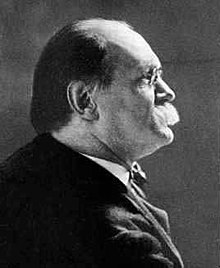Sam Loyd: Difference between revisions
| Line 82: | Line 82: | ||
* [http://www.samuelloyd.com/ Sam Loyd's Office - includes biography and his puzzles] |
* [http://www.samuelloyd.com/ Sam Loyd's Office - includes biography and his puzzles] |
||
* [http://www.invatasingur.ro/joculete/sam_lloyd.php Solve Loyd's 16 squares puzzle interactively] |
* [http://www.invatasingur.ro/joculete/sam_lloyd.php Solve Loyd's 16 squares puzzle interactively] |
||
* [http://www.jmrw.com/Chess/Loyd/base.htm 45 chess |
* [http://www.jmrw.com/Chess/Loyd/base.htm 45 chess problems Sam Loyd] |
||
Revision as of 06:07, 6 January 2009
- For people with a similar name, see Sam Lloyd.
Samuel Loyd (January 31, 1841–April 10, 1911), born in Philadelphia and raised in New York, was an American chess player, chess composer, puzzle author, and recreational mathematician.

As a chess composer, he authored a number of chess problems, often with witty themes. At his peak, Loyd was one of the best chess players in the U.S., and was ranked 15th in the world, according to chessmetrics.com. His playing style was flawed, as he tried to create fantastic combinations over the board, rather than simplifying and going for the win.
He played in the strong Paris tournament 1867 (won by Ignatz von Kolisch) with little success, placing near the bottom of the field.
Loyd claimed from 1891 until his death in 1911 that he invented the fifteen puzzle. However, a recent book[1] contends that he merely modified a previously existing puzzle.
An enthusiast of Tangram puzzles, Loyd published a book of seven hundred unique Tangram designs and a fanciful history of the origin of the Tangram.
Following his death, his book Cyclopedia of 5000 Puzzles[2] was published (1914) by his son. His son, named after his father dropped the 'Jr' from his name and started publishing reprints of his father's puzzles.[3] Loyd was inducted into the U.S. Chess Hall of Fame.
Excelsior problem
| a | b | c | d | e | f | g | h | ||
| 8 |  | 8 | |||||||
| 7 | 7 | ||||||||
| 6 | 6 | ||||||||
| 5 | 5 | ||||||||
| 4 | 4 | ||||||||
| 3 | 3 | ||||||||
| 2 | 2 | ||||||||
| 1 | 1 | ||||||||
| a | b | c | d | e | f | g | h | ||
- Main article: Excelsior (chess problem)
One of his best known chess problems is the following, called "Excelsior" by Loyd after the poem by Henry Wadsworth Longfellow. White is to move and checkmate black in five moves against any defense:
Loyd bet a friend that he could not pick a piece that didn't give mate in the main line, and when it was published in 1861 it was with the stipulation that white mates with "the least likely piece or pawn".
Trick Donkeys problem

Another of Loyd's notable puzzles was the "Trick Donkeys". It was based on a similar puzzle involving dogs published in 1857. In the problem, the solver must cut the drawing along the dotted lines and rearrange the three pieces so that the riders appear to be riding the donkeys.

This is one of Sam Loyd's most famous puzzles. Loyd's original instructions were to:
Start from that heart in the center and go three steps in a straight line in any one of the eight directions, north, south, east or west, or on the bias, as the ladies say, northeast, northwest, southeast or southwest. When you have gone three steps in a straight line, you will reach a square with a number on it, which indicates the second day's journey, as many steps as it tells, in a straight line in any of the eight directions. From this new point when reached, march on again according to the number indicated, and continue on, following the requirements of the numbers reached, until you come upon a square with a number which will carry you just one step beyond the border, when you are supposed to be out of the woods and can holler all you want, as you will have solved the puzzle.
First printed in the New York Journal and Advertiser, April 24, 1898 (as far as available evidence indicates).
The solution exists and can be found at details of Back from the Klondike puzzle.
Books
- Sam Loyd's Book of Tangram Puzzles (ISBN 0-486-22011-7): by Sam Loyd
- Mathematical Puzzles of Sam Loyd (ISBN 0-486-20498-7): selected and edited by Martin Gardner
- More Mathematical Puzzles of Sam Loyd (ISBN 0-486-20709-9): selected and edited by Martin Gardner
- The Puzzle King: Sam Loyd's Chess Problems and Selected Mathematical Puzzles (ISBN 1-886846-05-7): edited by Sid Pickard
- The 15 Puzzle (ISBN 1-890980-15-3): by Jerry Slocum and Dic Sonneveld
- Sam Loyd's Cyclopedia of 5000 Puzzles, Tricks and Conundrums with Answers ISBN 0-923891-78-1
- Sam Loyd and his Chess Problems by Alain C. White
See also
Further reading
- Sam Loyd: His Story and Best Problems, by Andrew Soltis, Chess Digest, 1995, ISBN 0-87568-267-7
References
External links
- Biography from the School of Mathematics and Statistics website at the University of St Andrews
- The Sam Loyd Cyclopedia of Puzzles - The complete 1914 book by Sam Loyd (public domain) scanned
- Sam Loyd's Puzzles - The complete 1912 book by Sam Loyd (free PDF download) scanned in color
- Farmer and Wife to Catch Rooster and Hen - interactive Sam Loyd's puzzle
- Sam Loyd player profile and games at Chessgames.com
- Chessmetrics entry for Loyd
- Sam Loyd's Office - includes biography and his puzzles
- Solve Loyd's 16 squares puzzle interactively
- 45 chess problems Sam Loyd
{{subst:#if:Loyd, Sam|}} [[Category:{{subst:#switch:{{subst:uc:1841}}
|| UNKNOWN | MISSING = Year of birth missing {{subst:#switch:{{subst:uc:1911}}||LIVING=(living people)}}
| #default = 1841 births
}}]] {{subst:#switch:{{subst:uc:1911}}
|| LIVING = | MISSING = | UNKNOWN = | #default =
}}
